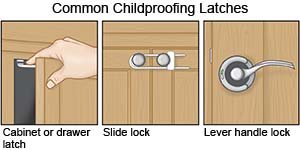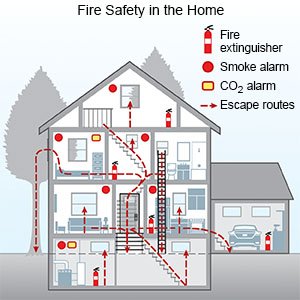How to Childproof your Home
Medically reviewed by Drugs.com. Last updated on Dec 2, 2024.
AMBULATORY CARE:
Childproofing
means taking precautions to keep your child safe. Many items in a home can be dangerous to children. Children are curious and like to explore. Babies also often put objects into their mouths. Childproofing helps prevent injuries as your child explores.
General safety precautions:
- Always use childproof latches and items made for childproofing. Some latches are made only to keep a door, lid, or drawer closed. Use childproof latches and locks to make sure your child cannot get to anything dangerous stored inside. Do not use tape, staples, or glue. These are not made for childproofing.

- Install fire alarms and carbon monoxide (CO) detectors. Put fire alarms on every floor of your house, in every bedroom, and in the kitchen. CO is a poisonous gas that has no odor. Put a CO detector outside every bedroom. Test them each month. Change the batteries at least once a year. Store matches and lighters where children cannot get to them. Have an escape plan in case of fire, and make sure your older child knows what to do. Talk to your child about fire safety.

- Keep the poison control center phone number where you will find it quickly. The phone number is 1-800-222-1222 . You may want to keep the number next to every phone, or program it into the phone to dial automatically.
- Childproof the inside and outside of your home. Remember to look at every floor in your home, including the basement and attic.
Childproof the inside of your home:
- Make stairs safe. Put self-latching gates at the bottoms and tops of stairs. Screw the gate to the wall at the tops of stairs. Install handrails for every staircase.
- Make doors safe. Put latches or manual sliding locks on all doors, or keep doors locked if possible. Put the latch or lock too high for a child to reach. Devices are available to prevent children from pinching their fingers or slamming the door on their hands. Put latches on old appliances, such as refrigerators. These may not open from the inside. If your child climbs in, he or she may not be able to get out and may suffocate.
- Make glass objects, windows, and doors safe. Do not leave breakable glass items where children can get to them. Put latches or locks on all windows. Safety netting can be installed to prevent your child from falling out of the window. Put stickers on glass doors so children do not walk into them.
- Make furniture safe. Put soft bumpers on furniture edges and corners. Remove furniture that has a glass top. Secure furniture, such as dressers and book cases, so your child cannot pull it over. Use cordless window shades, or get cords that do not have loops. You can also cut the loops. A child's head can fall through a looped cord, and the cord can become wrapped around his or her neck.
- Make electronics safe. Do not leave electrical cords out. Remove cords that are cracked, torn, or frayed. Cover electrical outlets. Tape the battery cover of electronic devices such as the TV in place. Remotes may use button batteries. The battery can become stuck in your baby's throat and cause choking or other serious damage. Store all batteries where children cannot get to them.
- Make playtime safe. Put all toys away when not in use. A baby can choke on toys that are safe for your older child. Do not leave plastic bags or deflated balloons out. These can suffocate a child.
Childproof your child's room:
- Get a crib made recently and that meets current safety standards. Make sure the slats of the crib are no wider than 2⅜ inches. This makes the slats too small for your baby's head to fit through. Check that the mattress fits snugly in the crib. Your baby could fall between the mattress and crib and become trapped.
- Do not put pillows or toys in your baby's crib. A pillow can fall onto your baby and suffocate him or her if he or she cannot get the pillow off. He or she could step on a toy and become high enough to fall out of the crib.
- Put the crib or bed in a safe place. Make sure no cords are near the bed or crib.
- Make your older child's bunkbed safe. Get a style that has a safety rail along the top bed. It should also have a secure ladder for getting down from the top bed. Never stack one regular bed on top of another.
- Use a changing table that has a safety strap. Use the strap every time your baby is on the changing table. Never leave your baby alone on top of a changing table. Keep one hand on your baby to keep him or her from falling.
Childproof the kitchen:
- Make the stove and oven safe. Put hard plastic covers over stove knobs so children cannot turn the knobs. You can also remove the knobs when you are not using the stove. Cook on back burners. Turn handles toward the back of the stove so your child cannot pull the pot or pan onto himself or herself. Put a latch on the oven door.
- Unplug portable appliances when not in use. A toaster, hot plate, or toaster oven can quickly burn a child.
- Store sharp cooking utensils safely. Put knives and other sharp kitchen tools where children cannot get to them. If possible, store them in a drawer or cabinet secured by a latch.
- Prevent drawers from slamming on your child's hand. Some drawers are made to close slowly. This can help prevent injury if your child slams the drawer. You can also screw a small plastic bumper inside the drawer so it cannot be slammed.
Childproof the bathroom:
- Never leave your child in the bathtub alone. Children can drown in even a small amount of water. Bring your child with you to answer the door or phone.
- Do not leave standing water in tubs or buckets. The top half of a baby's body is heavier than the bottom half. A baby who falls into a tub, bucket, or toilet may not be able to get out. Put a latch on every toilet lid.
- Prevent burns. Install anti-scalding devices on shower heads and faucets. Set your water temperature at 120°F (49°C). Check the water temperature before your baby or child goes in.
- Prevent cuts. Store sharp objects such as nail clippers and scissors where children cannot get to them.
- Prevent injury. Put nonslip stickers on the tub or shower floor. Cover the tub faucet with a rubber cover. Put a nonslip bath mat on the floor in front of the tub or shower.
- Prevent electric shocks. Unplug hair dryers, curling irons, and electric shavers when they are not in use. Do not use or leave any electric appliance near water.
Store dangerous items safely:
- Secure poisonous items. Store gasoline, detergents, pesticides, paint, and similar items where children cannot get to them. Put a latch on all cabinets used to store these items. Keep chemicals in the original container. Do not move them to food containers such as milk cartons. Your child may think it is drinkable. Some house plants are dangerous to children. Put all plants out of children's reach.
- Secure guns and other weapons. Store weapons in a locked cabinet. Do not store bullets with the gun.
- Store medicines and vitamins in childproof containers. Put a latch on any cabinet, container, or drawer used to store these items. Remember to secure any purse or bag that has extra medicine or vitamins.
Childproof the outside of your home:
- Make the pool, hot tub, or wading pool safe. Put a fence around the pool or hot tub. Use a hard pool cover. Children can get trapped in soft covers if they fall into the pool. Put a latch on the hot tub cover. Do not leave water in your child's wading pool.
- Make outdoor appliances safe. Put latches and knob covers on outdoor grills, smokers, and other cooking appliances. Put sharp forks and tongs where child cannot get to them.
- Store tools safely. Put all tools where children cannot get to them. Never leave building materials out while you are working.
© Copyright Merative 2024 Information is for End User's use only and may not be sold, redistributed or otherwise used for commercial purposes.
The above information is an educational aid only. It is not intended as medical advice for individual conditions or treatments. Talk to your doctor, nurse or pharmacist before following any medical regimen to see if it is safe and effective for you.
Learn more about How to Childproof your Home
Care guides
Further information
Always consult your healthcare provider to ensure the information displayed on this page applies to your personal circumstances.
